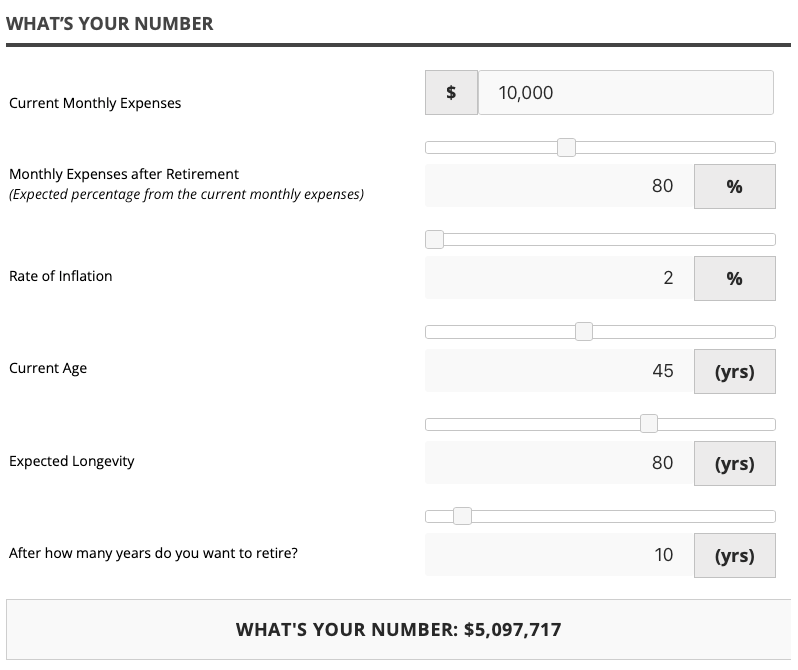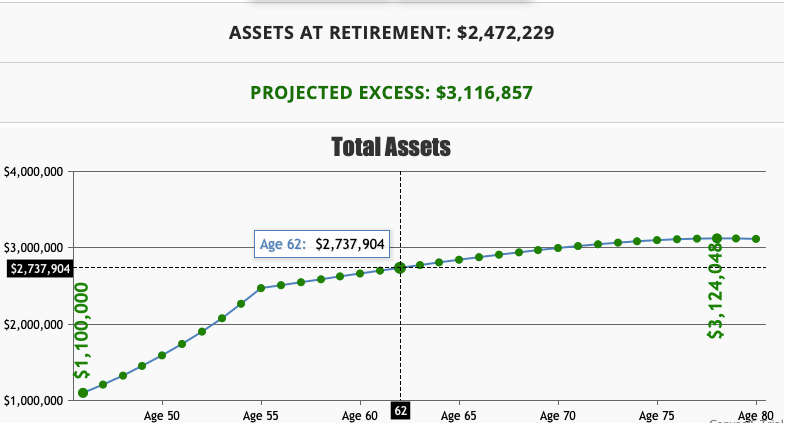What’s Your Number?
Is $2 million enough money for a comfortable retirement? The answer to this simple question is as unique and varied as each of us and our complex lives. Over the years I have had several conversations with friends about the money they think they need for retirement and the number they come up with often surprises me. The number is often overstated and the more assets they appear to already have, the higher the number appears to be. The concept of “your number” should ideally be simple enough where you know what you need to meet your monthly living expenses and a little extra for unforeseen circumstances. However there is a deep gorge between what is ideal and the ground reality.
Coming up with “your number” is difficult because it is a multi-faceted problem with a mix of unknowns, expectations, fears and desires. Some folks may not even have a good grasp of their monthly budget and savings. Starting today, we are rolling out a large number of free and paid tools on Inside Arbitrage that span the gamut of a DCF modeling tool to estimate the intrinsic value of an investment to a monthly budgeting tool that can help you figure out what your monthly budget is and how much you save. Once you have a handle on your total monthly income, your expenses, monthly savings and current assets (cash, investments, real estate, etc.), getting to “your number” may appear less daunting.
For me, my number is the amount of money invested in moderately safe investments that can generate the living expenses I would need in retirement with a little extra for emergencies so that the principal remains untouched. Let us unpack this statement and break it down.
- The first part is figuring out what your living expenses are likely to be in retirement. This is no easy feat because your future expenses may not be similar to your current expenses. You may no longer have commute costs if you don’t work anymore but your travel budget could increase if you plan to take more trips with all the free time you might have in retirement. You may no longer have to pay for your kid’s education but you may have higher healthcare costs as you age. Then there is the impact of inflation and cost of living adjustments based on the location you may choose to retire in.
I still remember filling up my beat-up Ford with gas that cost $1.44 per gallon as a grad student in Oregon twenty three years ago but now pay more than $5.50 per gallon in California. That number could just as easily be $10 per gallon if I plan to retire twenty years from now or we might be an all-electric world and there would be no gas stations. The state or country you choose to retire in can also have a huge impact on your expenses in retirement. There are seven U.S. states including Washington, Texas and Florida that don’t have personal income taxes. You might however end up paying more in property taxes or utilities if your retirement location is hotter or colder than where you live now.
- Once you estimate your monthly expenses in retirement, the second part is figuring out what kind of annual returns you can expect on your principal. Most financial advisors use a 4% rule of thumb. For example, if you need $40,000 a year to meet your expenses then you will need $1,000,000 in principal generating a 4% return on that principal. Keep in mind that as the years progress in retirement, inflation will continue to eat away into your purchasing power and you need to generate higher returns on your principal than what is required to meet your estimated monthly expenses.
- The third part is keeping the impact of inflation and taxes in mind. In year 10 of your retirement that $40,000 a year in expenses could have grown to $60,000. If your investments are only generating $40,000 a year in returns, you will have to dig into your $1 million principal to make up the shortfall. This is why your investments need to generate more money than you need to meet your monthly expenses in year 1 of your retirement. This extra money can go back into your principal and help you keep pace with inflation. If your investments are generating more than 8% a year then you may only need $500,000 to retire. On the other hand if your investments are generating a paltry 2% a year on average, you will need over $2 million just to meet $40,000 a year in expenses. This does not take into account the impact of taxes as most investment returns are likely to be taxed. They may not be taxed as highly as personal income from a job (W2 or 1099 income) but unless the retirement money is coming from a Roth IRA account, expect to pay taxes on it.
- The fourth part is planning for emergencies and unexpected (Black Swan) events. I have noticed that emergencies and unexpected events happen more often than people expect and unless you plan for them, they can cause a big dent in your retirement funds. If you expect to need $40,000 a year in expenses, it might be a good idea to bump that number up by 10% or 20% to account for emergencies.
- The last part is figuring out when you are likely to retire based on your current assets, your annual savings rate, the amount of money you need each year in retirement and your longevity. As you can see this is multi-faceted problem that can result in widely different outcomes and explains why I get answers that vary so much when I ask people, “what’s your number?”.
To make things easy, we decided to build the What’s Your Number tool that lets you play with all these factors to see what you number is and if you are likely to end up with a surplus or shortfall at the end of your expected life. If you are receiving this email, you already have free access to this tool by logging into Inside Arbitrage.
For example,
- if my currently after tax monthly expenses are $10,000,
- I expect I will need only 80% of those expenses in retirement,
- the average rate of inflation during this entire period is 2% a year,
- I am currently 45 years old,
- I am likely to live until the ripe old age of 80 and
- I expect to retire in 10 years
my number works out $5,097,717 or a little over $5 million.
If I currently have $1 million in liquid assets, those assets are generating 8% a year in after tax returns, I save an additional $20,000 each year before I retire and every year that saving rate goes up by 2%, I will have $2,472,229 or almost $2.5 million when I retire at the age of 55. Based on my expected longevity to age 80, after paying for my retirement expenses, I will be left with a surplus of $3.12 million that can go to my survivors or charity. In other words they would be enough to cover my retirement and my principal would have growth despite all the withdrawals. Adjusting for inflation, the purchasing power of that $3.12 million is likely to be significantly lower thirty five years from now.
Obviously all of this depends on the assumptions I provide to the What’s Your Number tool. An 8% after-tax return on a conservative portfolio may be overtly optimistic and a 2% inflation rate given our current environment may also seem optimistic. I plan to cover the impact of changing these numbers in an article next week. In the meantime, you can input your own assumptions to see how it impacts your number.
Editor’s note: This article was originally published on our sister site PowerCompounding.com and is being reproduced on Inside Arbitrage with some changes.


